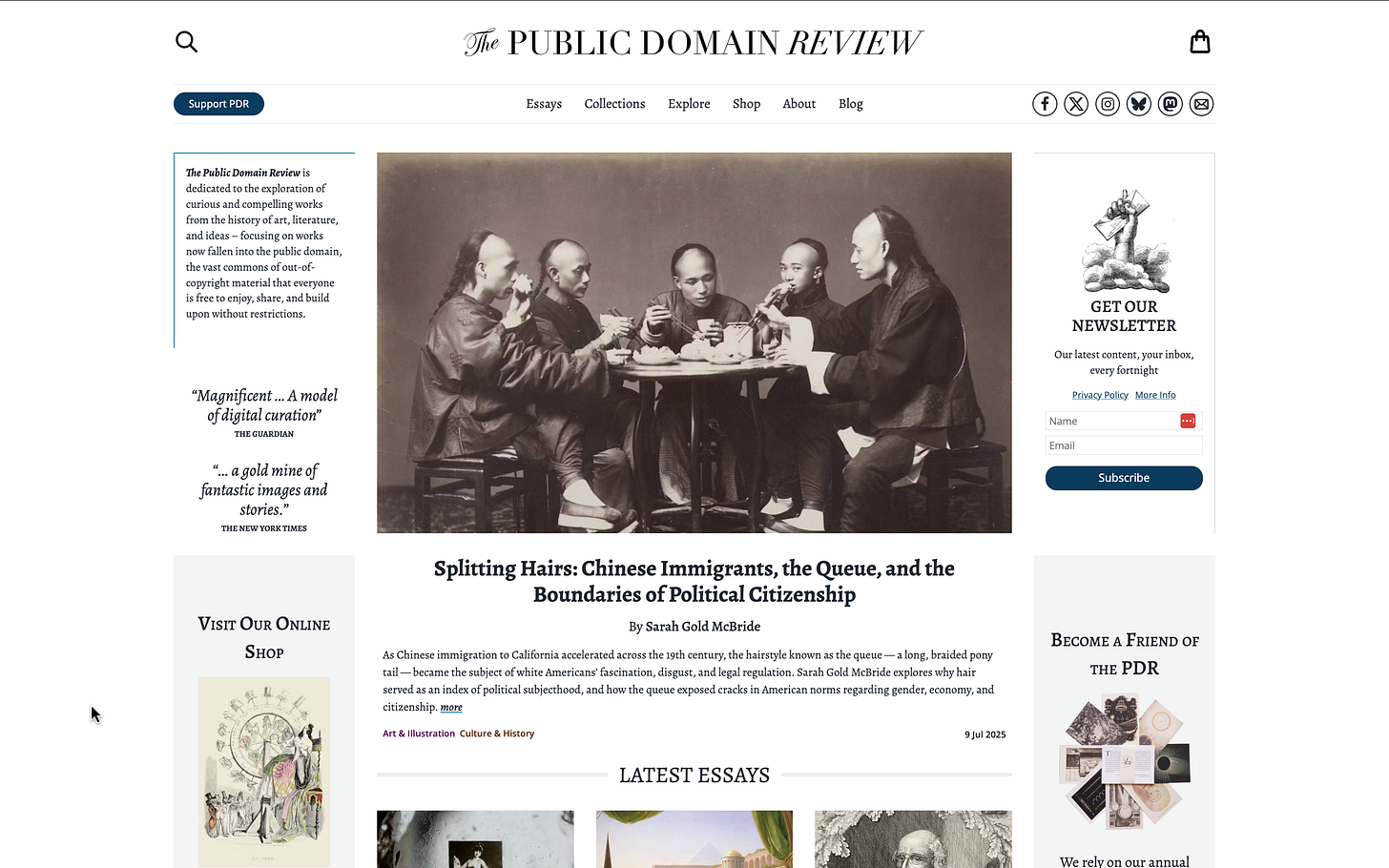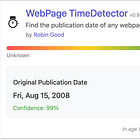Public Domain Archive - CM #34
Curated collections of PD works. Daily bite-sized vertical newsletters network. Newsletter curating life advice from books.
This newsletter is for subject matter experts, consultants, advisors and mentors wanting to be inspired on how to create value, visibility, authority and revenues by collecting, organizing and adding value to info / resources in their area of expertise.
In this issue:
Intro
3 Real-World Examples of Curation Monetized
New mini-app released
The long island summer is on.
Here on Koh Samui, fresh sea breezes, warm waters, wearing always the minimum needed not to be arrested, make living on a tropical island definitely worth the price of the ticket.
Running technically from January to October, the Thai summer, is also very hot and very variable. You can have splendid blue sky mornings and then series of cloudy afternoons and rain. On repeat. Like clockwork.
It’s not perfect, but it’s definitely good.
What makes me sad, is having seen my little social circle (3 friends), lovingly cultivated over the last few months, suddenly disappear. Didn’t do anything bad to them. They just moved on in their life journey and travels.
On the island are few the ones that stay for long.
Sadness notwithstanding I have been slowly persuading myself that this solitude and lack of social distractions may be a unique opportunity. To study, grow, apply myself to learn new things and be more useful to others like you.
If you like what I do please take 2 minutes to answer these 4 rapid-fire questions.
N.B.: This issue is lighter than the usual one as I do not have any new and relevant data-driven opportunities to share. The data source has temporarily run dry and I am wondering whether you have found these data pointers useful for you so far. Should I keep curating this type of data or not?
P.S.: I have just released the fourth mini-app created in as many months: Cape Canaveral (browser launch pad for apps and docs you need to periodically open). Check it out here.
Robin Good
Curation Monetized Real-World Examples (3)
In this section find real-world examples of existing online projects that generate revenue by organizing existing information, resources or tools as well as additional key opportunities that such projects (or similar ones) could leverage.
1) Curated Journal/Archive of Public-Domain Works
The Public Domain Review
Curated online journal of copyright-free works of art, literature and ideas.
Niche
Problem it solves: Providing inspiration, educating and helping discover the many valuable but little-known public domain resources and artefacts.
Audience: Individuals interested in culture, history, literature, the arts. Historians, educators, artists, designers, writers, cultural-heritage professionals, and intellectually curious general readers.
Tech
WordPress
Business
Business Model: Donations, Affiliate Commissions, Merchandising.
Price: Starts at $40/year
Sold via: Stripe
Author(s)
Jonathan Gray and Adam Green
Curator’s Job: Researching open-access collections; selecting noteworthy texts, images, film, and audio; writing or commissioning contextual essays; rights-labelling and metadata cleanup; image restoration; producing themed postcard packs and print products; managing contributor network.
Key Insights:
Key revenue channel is donations; extra revenue channels (prints, affiliate books, merchandising) do contribute profits but in a relatively small proportion compared to reader contributions. On the merchandising front PDR has an online shop offering t-shirts, mugs, postcards and prints. On the publishing one, PDR Press has been publishing anthologies, selected essays, classic works. PDR leverages also affiliate revenues coming from Bookshop.org.
The project is organised as a UK Community Interest Company, ensuring any surplus is reinvested in free cultural content.
Reader support currently brings in “a little over $140k/year,” funding ~400 staff hours per month; the target is $165 k by 2027 to add another full-time role.
Scale of curation: 1200+ digitised collections from 230+ institutions and 370+ long-form essays by 300+ authors, indicating a broad contributor ecosystem and steady content cadence.
(Source: The Public Domain Review)
*There is also a sister site dedicated exclusively to public domain images: The Public Domain Image Archive.
Key Opportunities:
1) Paid Digital Courses & Webinars
Offer short, curator-led workshops on sourcing, digitising, and creatively re-using public-domain materials, sold as one-off tickets or bundled with higher-tier memberships.
2) Licensing Bundle for Educators & Publishers
Package high-resolution, cleaned images with ready-made captions and lesson plans under a modest subscription, expanding reach into schools and textbook producers while staying mission-aligned.
3) Creative-Agency Inspiration Feed
Tiered annual subscription for design studios and advertising agencies that delivers monthly, themed image packs (print-ready files + colour-palette swatches) and an API for rapid search/download, positioning PDR as a go-to mood-board resource.
2) Daily Bite-Sized Vertical Newsletters Network
TLDR
Daily curated newsletters network covering the most interesting news on 14+ industry verticals from AI, to hw, security, design, dev, marketing, crypto & fintech.
Niche
Problem it solves: Keeping professionals informed on the most relevant breaking news in their specific sectors of interest.
Audience: Software engineers, startup founders, product managers, data / AI practitioners, tech-savvy investors.
Tech
N/A
Business
Business Model: Newsletter ads & sponsorship, Talent/Job platform.
Price: Newsletter ads starting at $1500. Typical newsletter sponsorship starting at 5K Source: https://tldr.tech/tldr-sponsor-kit.pdf
Sold via: Stripe
Author(s)
Dan Ni
Curator’s Job: Monitors 3k-4k RSS feeds, social channels, and niche forums
• Filters links with the “would I DM this to friends?” test
• Writes or edits 40-word summaries for each section
• Coordinates a network of vertical curators (paid hourly)
• Packages sponsor copy, tracks campaign metrics, and manages list-growth ads.
Key Insights:
- More than 1M subscribers and 5M annual revenue (July 2025)
- 1.25 million daily readers, ~40 % open rate as of Sept 2024, making it one of the largest independent tech newsletters
- In the same space as long-time player Smartbrief.
Operates 16+ vertical emails (AI, WebDev, Marketing, Design, Crypto, Founders, etc.) reaching >6 million tech professionals collectively.
Team
originally a solo operation; still <15 staff, relying heavily on freelance curators and a sponsorship CRM to scale 8× without proportional head-count growth.
Complementary flywheels — the free TLDR Talent job board funnels employer demand and supplies additional sponsor leads, deepening advertiser relationships.
Key Opportunities:
1) TLDR Pro Membership
Launch an optional $99 / year tier that bundles: early-morning “first look” editions, longer Sunday deep-dive explainers, and members-only Slack/Discord discussion. Converts power users, adds predictable recurring revenue, and leaves the core free list unchanged.
2) Enterprise API / Slack feed
Productise TLDR’s summarised link stream as a paid JSON / RSS API plus Slack & Teams apps. Corporate innovation teams and dev-tool vendors could embed curated headlines internally, paying per seat or per 1k calls.
3) Sponsor-performance dashboard SaaS
Expose the internal ad-tracking & UTM analytics as a self-serve portal for repeat advertisers. Charge a monthly platform fee for historical click-thru, cohort engagement, and A/B headline testing—turning a cost centre into software ARR.
3) Newsletter Curating Life Advice from Books
Book Freak
Weekly newsletter extracting useful practical advice from quality books.
Niche
Problem it solves: Distilling actionable wisdom from the vast volume of published books.
Audience: Self-improvement seekers, lifelong learners, designers & makers, productivity enthusiasts, general book lovers.
Tech
Substack
Business
Business Model: Paid Subscriptions, Affiliate Commissions, Newsletter ads & sponsorship.
Price: N/A
Sold via: Stripe
Author(s)
Mark Frauenfelder
Curator’s Job:
• Reads and excerpts non-fiction & literary works
• Selects 3–4 short passages offering practical guidance
• Writes brief contextual commentary and crafts click-through links
• Embeds sponsor copy and affiliate codes
• Publishes to Substack and mirrors to Cool Tools archive.
Key Insights:
BookFreak is a Substack newsletter with tens of thousands of subscribers in the books/lifestyle niche.
Book Freak is part of Cool Tools Lab, a three-person company that shares audience growth channels and ad-sales infrastructure across sister newsletters (Cool Tools, Recomendo, etc.)
Weekly cadence (≈50 issues/year) plus evergreen web archives create a long-tail of SEO traffic that continuously triggers affiliate book sales through Amazon affiliate links.
(Source: KK.org)
B2C productivity and writing-tool brands (e.g., Scrivener) use Book Freak for top-of-funnel awareness, suggesting CPM-style ad pricing with minimal operations overhead.
Key Opportunities:
1) Book Freak Pro Audio Edition
5-minute narrated audio file of each issue plus quarterly “mega-mix” playlists. Low lift (AI or contractor narration) and attractive for commuters & auditory learners.
2) Desk-card Inspiration Deck
Compile 100 of the highest-clicked excerpts into a boxed set of illustrated cards, sold on Amazon and the Cool Tools shop. Physical merchandise taps the existing maker/design audience and can bundle sponsor coupons.
3) Micro-learning license for teams
Offer a corporate subscription that pipes one curated excerpt per workday into Slack/Teams with attribution and book links. Priced per seat, it repackages existing content while expanding sponsor and affiliate upside.
4) Live “Book Freak Salon” webinars
Quarterly, ticketed Zoom sessions where Frauenfelder and guest authors discuss the books behind the most-read issues. Recorded sessions become bonus content for the Pro tier, creating a virtuous content loop.
Were these examples valuable for you?
If the answer is YES, please do click the heart / like button at the end of this newsletter, so that I know I am on the right track.
New Mini-App: Cape Canaveral
Have just released Cape Canaveral via
.Cape Canaveral is a Chrome extension that serves as a launchpad page for all those sets of documents, apps and resources that you need to periodically open.
It is the 4th mini-app I have vibe-coded in house. One mini-app every month is the challenge.
*For now, access to these mini-apps is reserved to all Premium subscribers, but I invite your feedback on this front, as some readers have started expressing preference for buying at a one-time low-cost price. What do you say?
**If you are a Premium subscriber here, you have already been granted a premium subscription to Good Tools. Thus, go straight to this post and scroll to the end to access the download link and simple installation instructions.
Premium subscribers to this newsletter:
a) can contact me and ask me questions privately
b) get access to the new mini-apps for creators and indie entrepreneurs that I am building with AI assistance and releasing monthly. Four mini-apps already available. (WebPage TimeDetector + CCPD Video Finder + Personal Tab + Cape Canaveral).
P.S.: If you care about this publication, please fill out this short survey, so I can know more of what you like and need.
Stop searching for something new.
Organize and add value to what is already there.
from sunny-hot Koh Samui (TH)
Robin Good
.










